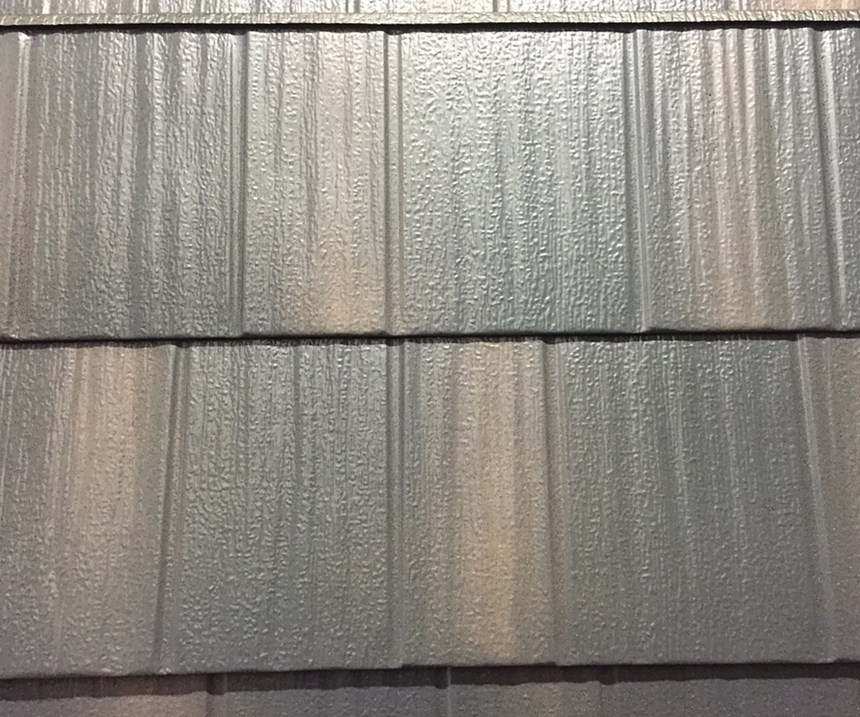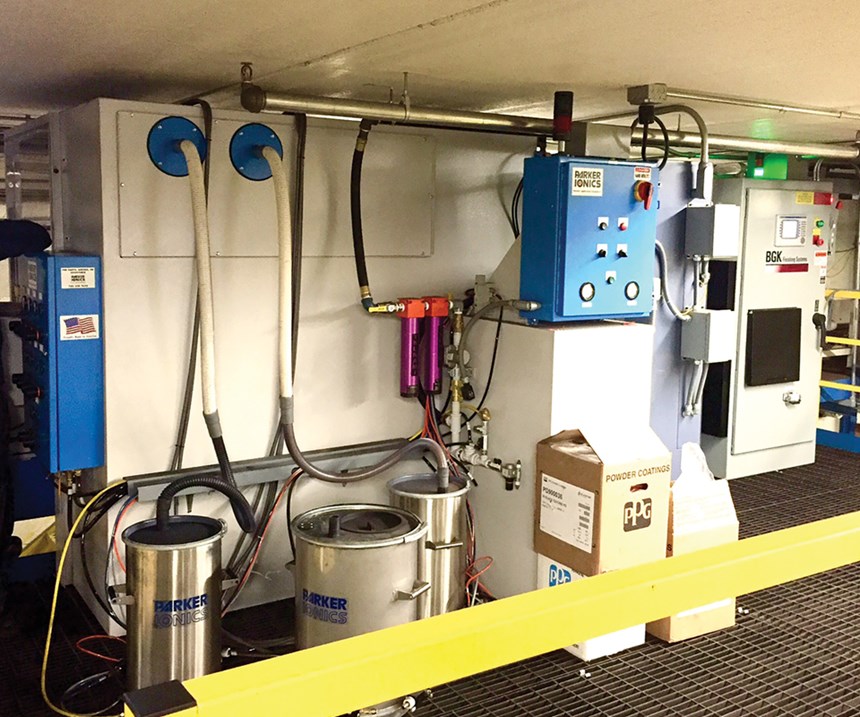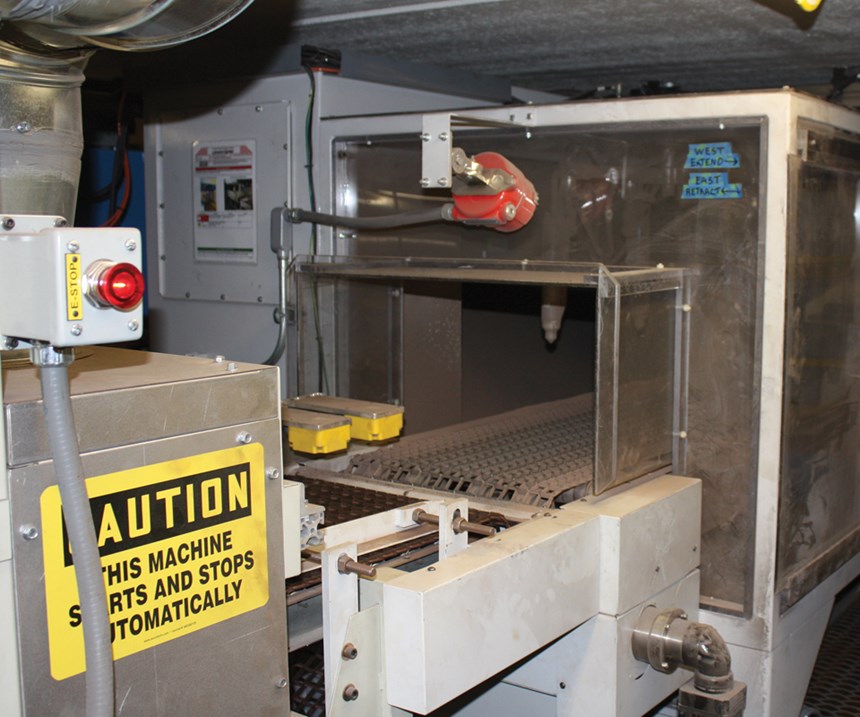Raising the Roof with Unique Powder Coating Application
Edco Products taps Parker Ionics for 'random pattern' coating system for its on its roofing materials.
Edco Products’ Mike Bergeson smiles proudly when he looks at the metal shingles his company produces in its Minnesota plant, then offers an assessment that would catch many industrial finishers off guard.
“It’s the lousiest looking powder coat job you’ve ever seen,” says Bergeson, the director of manufacturing for Edco, a manufacturer of residential and commercial exterior building products located in Hopkins, just outside of Minneapolis.
Featured Content
Of course, the metal shingle is one of the best in the business, but the finished look is what makes Bergeson and Edco engineers beam: the random finish of the coating may be the angst of finishers everywhere else, but it is exactly what the company set out to do.
“We applied liquid coating previously to one of our products that had a very random look to it,” says Brad Newell, the company’s product training manager. “It really worked well for contractors who could grab the product out of the box and install it without worrying about what order it needed to be in. It gave us a nice staggered pattern.”
Four years ago, Edco began looking at applying the random finish on its roofing materials. They originally started the research by applying a powder coating on top of a liquid application, but were not happy with the results.
Bergeson says the idea was then hatched to apply the powder coating directly onto the roof shingle, but they still needed to get a random pattern to the look. The effort proved more difficult than they anticipated.
“The biggest hurdle was to get a powder coating company to come in here and wrap their heads around what it was we needed exactly,” he says. “Everybody wants to have a beautiful powder coat, and we wanted a nice finish, just not consistent in the look. That took some time to get people to understand.”
Building a Different System
After meeting with Parker Ionics from Westland, Michigan, Edco soon found a partner to try the unorthodox finishing system. Brian Garvey, Parker Ionics’ northern Midwest regional sales manager since 2008, paid Edco a visit and saw right away what the company was trying to do.
“They wanted a textured shingle look, which has a very random appearance,” Garvey says. “They were getting a good look with the liquid application, but it made the surface very slippery and so the snow would come sliding off, or people really couldn’t work on the roof because of how slick it was. So, we had the challenge of appearance, but we also had to make it a very high-quality product that they could stand behind.”
Garvey and John Cole, president of Parker Ionics, have installed hundreds of powder coating systems over the past few decades, but the request by Edco made them pause.
“Everything we knew about applying powder coating, we basically had to throw that out of the window based on what they wanted us to help them with,” Garvey says. “When a customer tells you they don’t want a uniform finish, it makes you rethink your approach.”
Edco Products is one of the largest makers of residential steel roofs and siding in the U.S., and it is also one of the longest-running steel and metals companies, having been founded in 1946 by the Edwards family in Hopkins. Family patriarch Arthur Edwards noticed a mounting need for affordable building materials following World War II, and started an insulated siding business with his family.
The asphalt-based siding material was one of the first on the market, leading the way in a growing industry as the product found popularity with builders across the U.S. Currently, Edco manufactures steel roofs and siding, as well as a product line that has expanded through nationwide distributors to include aluminum soffit and steel fascia, metal shingles, aluminum gutters and downspouts, and a large line of siding accessories.
Textured Appearance
Bergeson says one issue the company had was that while the Edco shingle looked like a textured shingle when it was installed, its texture did not assimilate like a normal shingle.
“It just didn’t feel right,” he says. “A lot of companies have a stone-coated metal shingle, but you run into the same problem as with an asphalt shingle, in that the stones will wear off over time through weathering. Then you have rust spots on the roof that will develop where the granules came off. And then you have the granules clogging up gutters; there is a whole host of issues with a stone-coated finish.”
So, the Edco engineering team had to come up with a way to make the metal shingles feel and look like they had granules on them, but also have a finish that was inherently bonded to the shingle so that it wouldn’t have issues with rust.
Chris Doucet, Edco’s director of sales and marketing, says the need for the new shingle came from a heavy demand.
Steel roofs usually last a lifetime, often lower energy costs, can survive more extreme weather, and are backed by a better guarantee than almost any other roofing product on the market.
“Consumer demand was extremely high for this type of product,” Doucet says. “We are always trying to find ways to expand our product offering and to attract more customers to what we do. So, we set out to deliver something that was as close as we could get to looking like an architectural shingle, and still deliver all the benefits of metal roofing.”
Besides durability and energy savings, Edco steel roofs have high ratings for hail and wind—they can withstand gusts of up to 160 mph, well above the industry standard. (For perspective, Hurricane Sandy reached speeds of 90 mph.)
Polyvinylidene Fluoride Resin
The metal roof shingles begin as a coil of steel that passes through a seven-stage surface prep area before getting a primer and a topcoat of a polyvinylidene fluoride resin. It is then baked and rolled back into a coil to be moved to another location on the Edco manufacturing campus.
The metal is uncoiled and a stamping system produces individual shingles, which is where Edco wanted to apply the powder coating for highlights and texture to give it that random look and improve the quality of the finish.
“The biggest thing was to get a powder coating company to believe in what we wanted to do,” Bergeson says. “We had a couple of equipment makers to whom we explained what we needed, and we were told ‘It can’t be done.’ That was a little frustrating, to say the least.”
He says the biggest impetus was that some of the companies could not “wrap their heads” around what Edco wanted to do, and in turn walked away from the project.
“I think they all had some vision of this beautiful finish coat,” Bergeson says. “And what we were asking for was the lousiest job as far as consistency goes, and that proved difficult for many of them.”
When Edco spoke with Parker Ionics, they found a willing partner to help them engineer an unorthodox coating system.
“Brian thought it was a great idea,” Bergeson says. “He saw right away where we wanted to go with it.”
Parker Ionics knew right away that Edco wanted a random “architectural stripe” that would give it the look it needed; the issue then became tinkering with the Parker Ionics’ equipment to help them get to that solution.
Custom Design
“Our first thought was this needed to be designed more like a fertilizer spreader rather than a powder coating line,” Garvey says. “We needed to spread out the powder coating and make it as random as could be.”
The coil line was set to run at around 140 feet per minute, so Garvey and Cole helped engineer the system so that it slowed down to about 40 feet per minute so it can get ready to accept the three random applications of the powder coating onto the shingle; when the shingle gets to the coating guns, it stops completely before getting a finish and then heads off to the oven to cure.
“The system can coat one shingle about every six seconds,” Garvey says.
Parker Ionics had to use special nozzles on its powder coating guns to make sure the spray pattern was wide, and the timing right. The mechanisms that moved the spray guns were also specially engineered.
When Garvey went to the Edco plant, he tested the system offline to see how the look of the random pattern met the company’s expectations. Several prototypes were made before the company settled on one to their likening.
“When we had the right design down, we then went to different colors and varied some of the patterns because we wanted to get a good architectural look,” Garvey says.
Likewise, Edco took samples to consumers to test market appeal.
Focus Group Testing
“We did a lot of consumer focus groups before we made a final decision on what pattern we would be using,” Doucet says. “We didn’t tell people what they were there for, and we brought a lot of different products from us and from our competitors to show them, just to make sure we were getting accurate feedback.”
The new shingle line—the Infiniti product series—stood out as a big favorite among consumers.
“It really reinforced in our mind that we had a winner with this style,” Doucet says.
That sent the Edco team and Parker Ionics into full production to get the coating up and running and integrated into the line. The first set of spray guns are stationary, and the second set are on a mover to get the desired pattern.
“It actually wasn’t too big a hurdle,” says Jesse Klover, Edco’s project engineer on the Infiniti series who worked closely with Parker Ionics to get the line working. “We had a few tweaks to make here and there, but overall it has worked really well for us.”
In April 2016, Edco introduced the Infiniti products to the market with great success. The company now has the shingle available in five colors, and contractors are liking the results.
“We far exceeded even our most optimistic outlook for the product,” Doucet says. “We originally launched with two colors to get a sense of how it would be received, but we expanded that quickly a few months later by three more colors. We really feel this will be the next big thing
in roofing.”
One of their largest contractors tried the Infiniti product and immediately loved the look and durability of the product, and especially its light weight.
“He said it was the nicest roof he had ever put on, hands down,” Bergeson says. “He ended up putting it on his own house. That is a major statement.”
For information on Edco Products, please visit edcoproducts.com; for information on Parker Ionics, visit parkerionics.com.
Originally published in the May 2017 issue.
RELATED CONTENT
-
Developments and Trends in Powder Coating
New solutions for powder coating centers combine powder preparation, conveyance, dosing and color changes into a fully automated, closed system.
-
Improving Transfer Efficiencies in Coating Operations
There are many methods for addressing electrostatic grounding in metal painting processes, and Tim Ulshafer from Mueller Electric says the best method for your process is a simple and worthwhile exercise.
-
Touch-up Options for Powder Coated Parts
Is it true that powder coating cannot be touched up? Powder coating expert Rodger Talbert offers options for powder coating touch-ups.
























